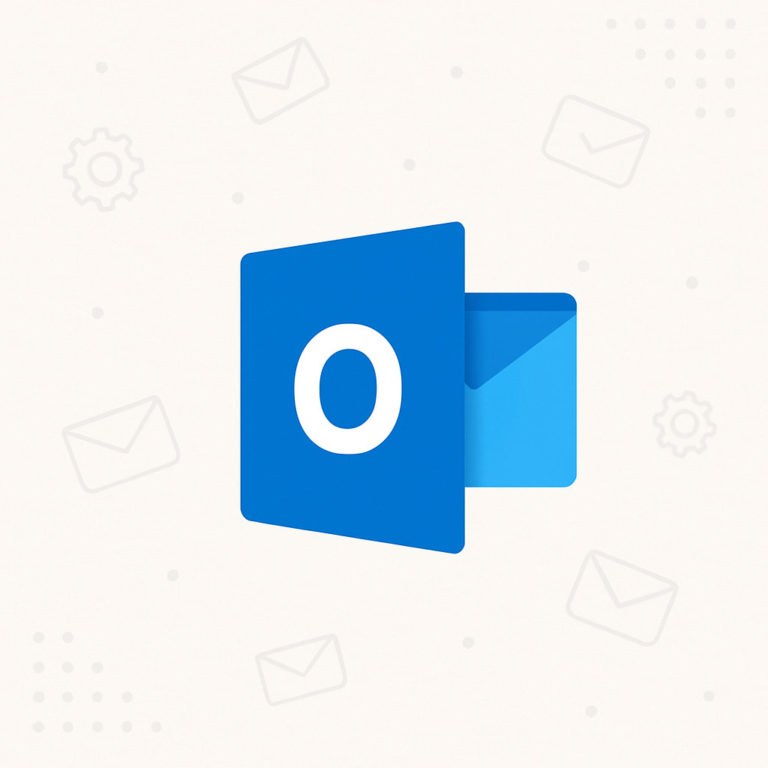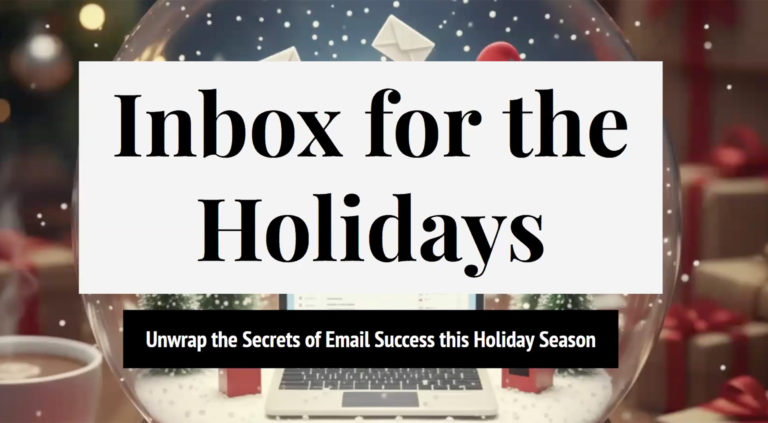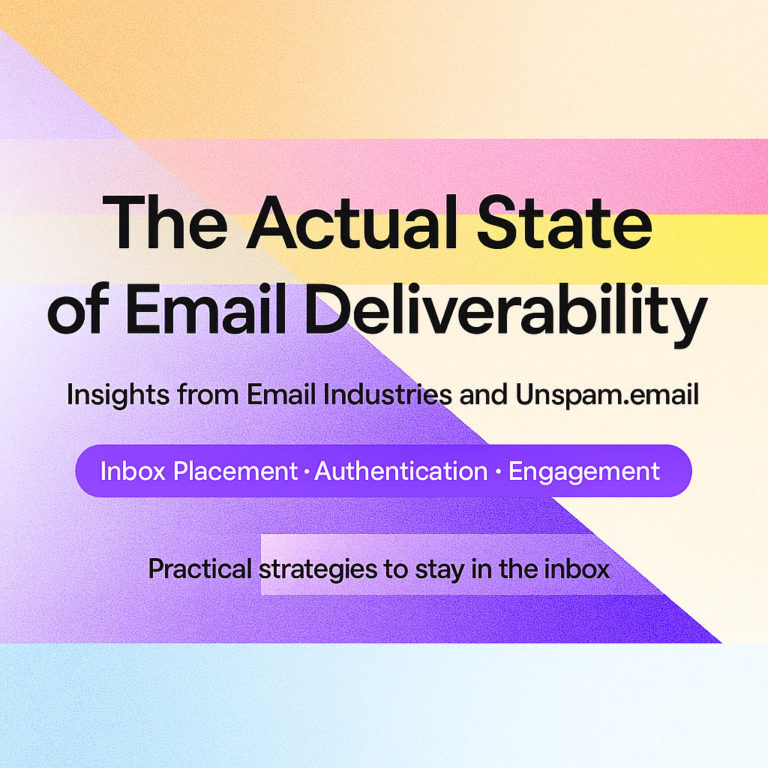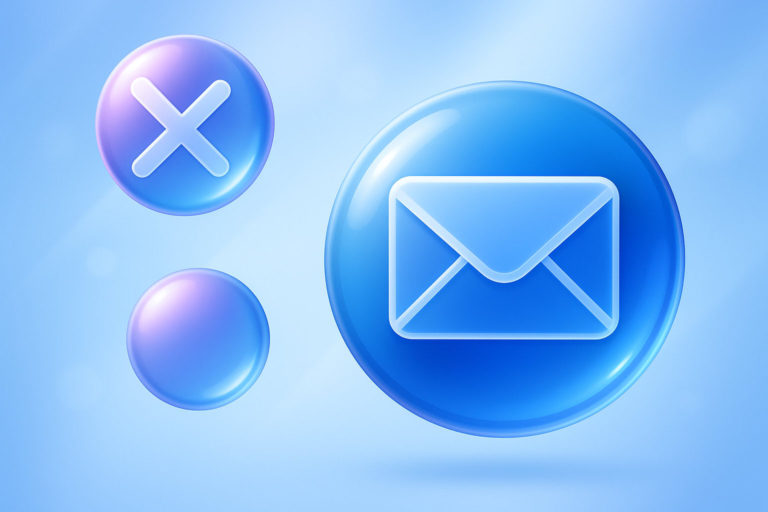A lot has changed since the first spam filters were introduced. They are no longer fairly rudimentary algorithms that solely react to spammy language in the content. Today they inspect not only email body copy but also all critical details of the communication starting with the subject line and ending with authentication and brand blacklisting. They are advanced, regularly updated mechanisms that keep unwanted emails out of users’ inboxes through multiple security measures.
Actively fighting cybercriminals to provide users with a secure email ecosystem, they often affect legitimate businesses as their correspondence might look suspicious to them. For many companies, it could be a true challenge to bypass email spam filters and deliver their brand message to the customer’s door. However, those who adopt the best practices in email channels and always stay on the “light” side have more chances to convince these fearsome “bouncers” to let them in.
Let’s consider the top proven strategies that help companies across niches bypass email spam filters and improve their email deliverability.
Why Is It Important to Bypass Email Spam Filters
As email remains one of the most productive and cost-effective channels for companies to achieve their short- and long-term goals in marketing and branding, it is crucial to bypass the email spam filters of ISPs and mailbox providers. With uninterrupted direct outreach, companies may unlock the true potential of email channels and benefit companies in many ways.
First and foremost, they might reach a large audience, which means more exposure for a business, increased brand awareness, and improved engagement.
Second, they might grasp every opportunity to deliver valuable messages to the audience, elevate their satisfaction with the brand, or make a sale.
Third, they might improve email deliverability, directly affecting key performance metrics, including open rates, reading time, conversions, leads, and ROI.
Finally, they might drive better outcomes from their email marketing efforts, maximizing their investment in the campaign and strategy.
Companies that successfully bypass email spam filters build strong brand identities and reputations. They increase brand and product positioning in the market, fight competition, and reinforce the foundation for growth and development.
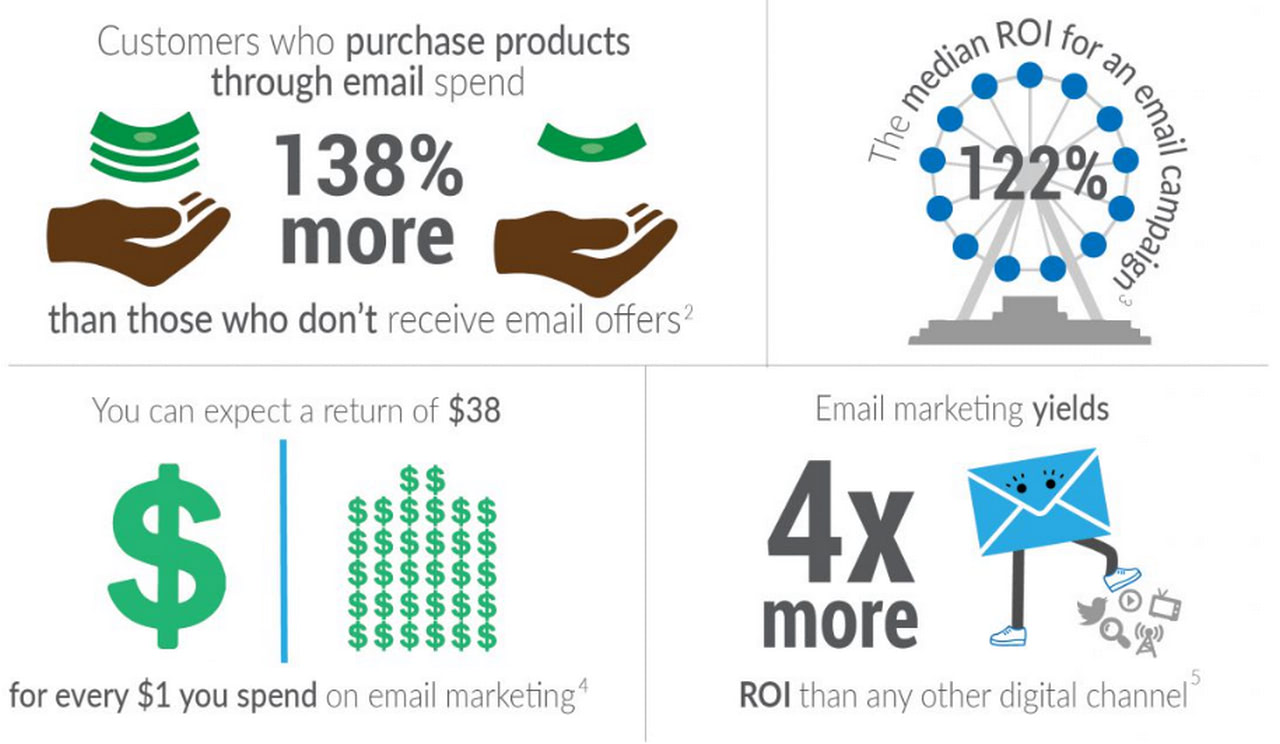
Email ROI (snippet from infographic by Digital Strike)
Top Proven Strategies to Bypass Email Spam Filters
So, how do you stack the odds in your email’s favor and bypass email spam filters to enjoy all the benefits of direct outreach? Here are the top proven strategies to introduce in your email marketing routine.
Authenticate Emails
Authenticating email is perhaps one of the most important technical things a company should perfect to ensure its digital correspondence bypasses email spam filters. First and foremost, it has become a must-have for companies that want to reach their Gmail subscribers. In 2024, Google announced it would reject any email without properly configured SPF, DKIM, and DMARC. As for Apple and Yahoo, the other two big players in the email arena, they also stressed the importance of email authentication for businesses across niches the same year.
Second, email authentication helps to fight phishing attacks and email spoofing. It decreases malware distribution risks and safeguards users from losing sensitive information, protecting the email channel.
Third, authenticated emails earn trust with ISPs, mailbox providers, and anti-spam organizations. As the company not only ensures its legitimacy but also participates in the active protection of email channels, it builds a strong reputation as a trustworthy partner in the ecosystem.
Finally, authentication provides a layer of legal protection for companies. By protecting data privacy and minimizing risks of unauthorized access to users’ sensitive data, companies meet email security regulatory requirements established by CAN-SPAM, GDPR, and CCPA.
So, authenticating emails is the first step for companies to increase their chances of bypassing email spam filters. Here are the main steps they should take to realize it in practice:
- Configure the branded domain and “from” name for digital correspondence.
- Add a list of authorized IP addresses to the sender’s domain name system.
- Configure DKIM signatures for every message.
- Set up a DMARC record on their domain.
- Update private and public keys regularly.
- Have a valid forward and reverse DNS record for sending IP addresses.
- Set up a custom Return-Path domain.
- Ensure IP addresses are not blacklisting and have a high sender score.
Apart from the basic yet essential infrastructure settings, it is also highly recommended to warm up new IP addresses or domains, especially for new businesses. Gradually increasing the volume of mail sent helps to earn trust with ISPs and mailbox providers and establishes itself as a credible participant that employs the best email marketing practices. This builds a strong brand reputation that positively impacts the sender’s reputation and score.
Test Email Body Copy Against Spam
As email providers are now looking at behavioral signals, focusing on customer engagement and reactions to interactions with the brand, poor quality of email body copy has become the top reason for companies being caught by spam filters.
With Artificial Intelligence powering anti-spam mechanisms, ISPs and mailbox vendors have the luxury of checking every key detail of emails, leaving no stone unturned in their pursuit to find things that might look suspicious. From broken links to pushy rhetoric, they inspect multiple specific criteria before deciding what to do with the correspondence.
Such critical factors as
- irrelevant content,
- spammy words,
- rude or pushy language,
- capitalization,
- the unhealthy balance between images and text,
- broken links,
- shortened links,
- too many links,
- attachments,
- use of unsupported formats,
- poor formatting,
- incorrect spelling and grammar mistakes,
- poor design,
- non-optimized, mobile-unfriendly, unresponsive, and inaccessible email structure,
- and glitchy HTML code
easily raise red flags and make ISPs and mailbox providers reject correspondence or place it in the spam folder. Therefore, one of the best strategies to bypass email spam filters is to ensure email body copy meets their high standards. Here are what you can do:
- Create hyper-personalized email body copy based on the recipient’s current needs, preferences, behavior patterns, and previous experience with the company.
- Use a responsive and mobile-friendly template.
- Optimize visual material so as not to overload the email.
- Avoid spam words, jargon, pushy language, or deceiving lead magnets.
- Make sure all links are working and correctly highlighted.
- Add a functional email footer with the company’s physical address, contact information, social media icons, brand identity, and, most importantly, an unsubscribe link.
- Ensure great reading experience through formatting and clear information hierarchy.
- Add alts to images, strike optimal contrast between background and foreground, and try to apply accessibility standards wherever possible.
- Use allowed typefaces.
- Eliminate confusion, misunderstanding, and tricky messages.
- Play carefully with psychological tricks like FOMO, urgency, or exclusivity.
- Proofread the email body copy to avoid mistakes and faux pas.
- Align your subject line and email copy to set and live up to the brand expectations.
- Track and improve open rates, clicks, reading time, and engagement.
Finally, always check email against spam and test deliverability through Unspam. This holistic, AI-powered platform will run all mandatory checks against spamming. It will surface all faux pas that might trigger red flags, including spammy language, broken or shortened links, poor text-to-image ratio, glitchy HTML code, and more.
On top of that, Unspam offers great functionality for polishing your email outreach from the technical side. For instance, it has email monitoring features with handy data-backed deliverability reports. It also tracks your IP and domain reputation as well as SPF, DKIM, and DMARC authentication and figure out if you are on one of the popular blacklist vendors’ databases.
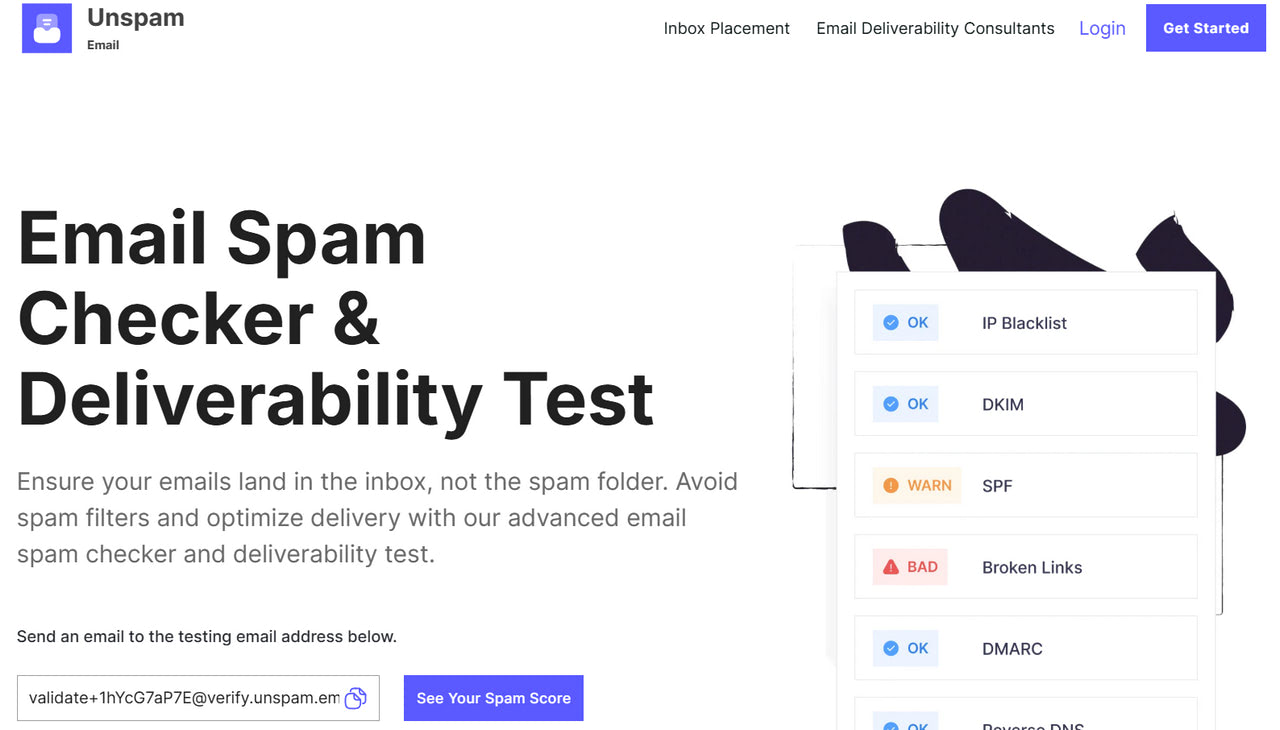
Unspam – professional email spam checker and deliverability test
Build Strong Sender’s Score and Reputation
The sender’s score numerically represents the company’s sending reputation assigned by ISPs and mailbox providers. It depends on multiple factors, starting with the company’s past email-sending behavior and ending with the recent email engagement metrics.
If a company has a low email sender reputation, ISPs and mailbox providers are more likely to reject your email or put it into a spam folder by default. If it is high, the company’s message will likely bypass email spam filters and get to the subscriber’s inbox.
There is more. The sender’s score plays a crucial role in a company’s overall success in the email channel. As it represents the company’s overall behavior, it may guarantee its credibility, authenticity, and honest intentions. It directly affects the deliverability rate and customer engagement with the brand.
Therefore, contributing to your sender’s score and reputation is the top technique that, in the long run, allows the company to bypass email spam filters and improve its positioning in the channel.
Among the top recommendations for building and reinforcing a positive sender’s score and reputation are:
- Improve key metrics that influence it. This includes the open rate, reading rate, click-through rate, conversions, and overall engagement.
- Minimize negative email metrics. This includes soft bounces, hard bounces, spam rates, spam complaints, and unsubscribe rates.
- Enhance email engagement by creating a relevant and valuable brand message.
- Clean your subscription list regularly to remove invalid addresses and spam traps.
- Check your IP and domain against blacklisting.
- Create a consistent email marketing plan and adhere to your promised cadence even during peak sale seasons.
- Avoid spikes in the volume of outbound emails.
- Never buy or rent contacts. Reach only those who have given their permission.
- Use Unspam to get crucial knowledge on improving inbox placement and deliverability rates.
Last, but not least, it would also help to use reputable email service providers with good reputations and relationships with key participants in the email ecosystem. Therefore, ensure your choice of ESP meets high standards.
Stay Away from Blacklists
Having the IP or domain added to a blacklist can seriously affect the company’s presence on the channel. First and foremost, it may halt its activity completely. Second, it minimizes its chances of getting through rigorous ISPs and mailbox security algorithms. Third, it ruins the company’s reputation among clients. Finally, it harms email performance and the company’s ability to generate leads and revenue as it starts missing business opportunities.
Staying away from email blacklists is one of the best strategies to bypass email spam filters that come with such extra perks as improving email deliverability and maintaining your hardly-earned sender’s score unaffected.
There are many reasons why a company may end up on a blacklist. It could be caused by spam complaints, too many outbound emails, email spoofing, viruses, malware, poor authentication, or a pristine spam trap.
To make matters worse, there are dozens of blacklist providers out there. Although not all of them may lead to the company’s full isolation from the email channel, still being caught even by a small blacklist vendor might have negative impacts. Therefore, it is crucial to avoid them at all. Here are the top recommendations on how to do this:
- Never buy or rent email contacts.
- Remove spam traps from your mailing list.
- Remove emails that cause hard bounces.
- Closely monitor soft bounces.
- Always address spam complaints.
- Make the unsubscribing process easy, quick, and simple.
- Keep your subscription list clean and engaged.
- Create personalized, valuable, and relevant email content to ensure high engagement with readers.
Finally, regularly check blacklist vendors. As many vendors do not send notifications about catching negligent businesses, the only way to determine whether you are in is to check it yourself. At least eight of them make it increasingly hard to get off the directory and require the company to revise its email marketing strategy and prove that they have fixed issues. So, start with them and conduct regular blacklisting checks through Unspam to act right in time.
Take Seriously Unsubscribe Process
Allowing recipients to unsubscribe from your mailing list easily is not just a rule of etiquette; though, it certainly demonstrates your commitment to building honest and mutually respected relationships with customers. In fact, it is much more than just polite behavior and expressing good manners.
First, companies that practice no-strings-attached relationships with their customers and address their requests to leave the mailing list immediately comply with anti-spam legislation established by CAN-SPAM and GDPR rules. By protecting people’s data and respecting their decisions, they operate on the “light” side and prove their reliability, credibility, and legitimacy to key participants of the email ecosystem.
Second, it minimizes spam complaints and spam rates. When your readers have an easy and quick option to leave, they are unlikely to register, complain, or flag your email as spam. They just leave without damaging the brand’s reputation.
Third, it reinforces the company’s position in the email channel. Letting your users unsubscribe whenever they want makes your mailing list clean and healthy. That means key deliverability metrics will not suffer from accidental hard and soft bounces.
Finally, it strengthens the brand’s image and reputation. By letting go of those disengaged with the brand, companies ensure they are less likely to share negative feedback about the company. In the best case, they may even come back.
All these factors are crucial when ISPs and mailboxes’ spam filters decide whether to reject or accept email. Therefore, taking seriously the unsubscribe process is one of the best strategies to adopt. Here are what companies can do:
- Add a link to the unsubscribe form to every email sent, whether it is a welcome message, follow-up, or automatically generated transactional reminder.
- Highlight the unsubscribe link in the body of the email. Make it easily discernable from the text.
- Make the unsubscribe process quick and easy. Do not doubt the reader’s decision to leave.
- Address unsubscribe requests as fast as possible.
Avoid Misleading Subject Lines
Do you know that a misleading subject line is among the top reasons subscribers register complaints or place messages in their spam folders? No one likes to be deceived. Companies that do not live up to their brand promises, ruining customers’ expectations, always face the aftermath of poor customer experience and dissatisfaction with the company. Their messages are more likely to be filtered by ISPs and mailbox anti-spam algorithms.
Therefore, do not make the subject line an afterthought. It must be prioritized because it sets the right customer expectations and is your only chance to make the first impression count. Ensure it is personalized, grammatically correct, non-pushy, concise, and straight to the point.
Build Strong and Transparent Relationships with Customers
One of the best practices that help companies bypass email spam filters centers around building strong, healthy, and transparent customer relationships. When you gain your readers’ trust by delivering true value with every outreach, they will likely engage with your message. The more engaged customers are with the brand, the more positive attitude ISPs and mailbox providers will have towards the company.
Customer relationships are fundamental for a company’s continuous operation in the channel. They lead to improved customer loyalty and satisfied customers who will likely return to your brand over others. This decreases customer churn and enhances the brand’s sending score and reputation.
There are many ways to improve your relationships with customers. For starters, get permission to send every email you need, from promo to reminder. Provide them quick access to the email preference center so they can adjust the email settings how and when they like. Also, ensure the unsubscribe process is simple and fast.
When your relationships are getting stronger, you may ask your subscribers to whitelist your company. This means they add your company’s address to their approved senders list, telling email clients that they trust this correspondence. This guarantees emails bypass email spam filters and end up in the inbox instead of the junk folder.
Test Email Deliverability
Last but not least, testing email deliverability and other critical details of outreach, from rendering to inbox placement, is the top strategy to help companies bypass email spam filters. Email testing is the only way to optimize your email campaign by making decisions based on real-time, relevant data. It eliminates guessing games and provides companies with accurate solutions that maximize the productivity of their actions.
These tests spot problems covering crucial areas such as email content, formatting, and technical aspects that might trigger spam filters. Consequently, testing and improving email deliverability positively influence companies’ chances of bypassing strict anti-spam mechanisms and delivering a message to recipients.
The easiest way to test email deliverability is to use Unspam. It does numerous checks that are crucial to assessing email deliverability. On top of that, it offers a holistic approach to solving email deliverability problems with its talented pool of experts.
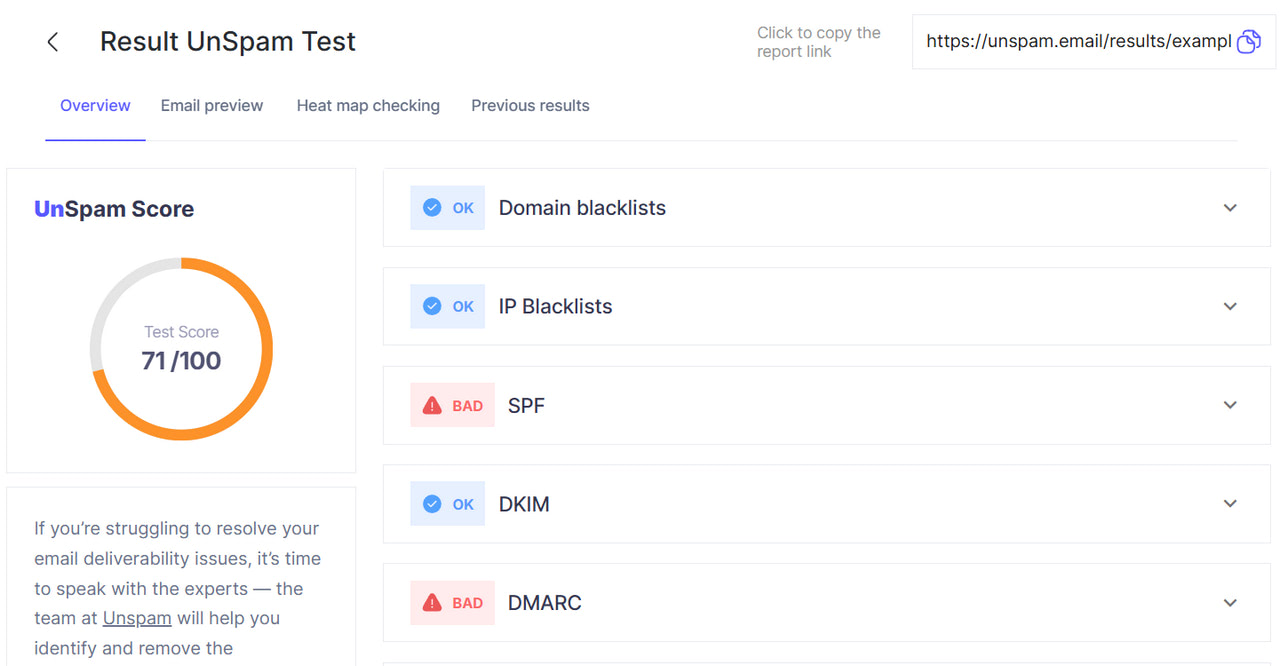
Deliverability report by Unspam
Conclusion
Email channel comes with numerous perks. It is the most effective way to reach your customers directly. It gives companies control of every aspect of their interaction and message delivery. And with all that, it does not depend on changes in advertising costs or search algorithms.
However, the email channel has its share of challenges. Among all the obstacles companies might find on their path to subscribers’ inboxes, spam filters are the most rigorous and annoying. These fearsome “bouncers” can cause headaches even to the most established and respected companies by preventing legitimate messages from reaching recipients.
The good news is that companies may stack the odds in their favor and ensure their brand messages reach destinations. They must adopt strategies devised to bypass email spam filters and prove the connection’s legitimacy, credibility, and reliability to the ISPs and mailbox vendors. This includes authenticating emails, checking email body copy in Unspam, building strong relationships with customers, avoiding misleading subject lines, prioritizing the unsubscribe process, and testing deliverability to make informed decisions.


